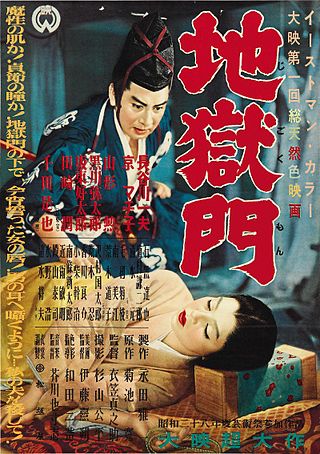
The cinema of Japan, also known domestically as hōga, has a history that spans more than 100 years. Japan has one of the oldest and largest film industries in the world; as of 2021, it was the fourth largest by number of feature films produced. In 2011, Japan produced 411 feature films that earned 54.9% of a box office total of US$2.338 billion. Films have been produced in Japan since 1897, when the first foreign cameramen arrived.
The Nikkatsu Corporation is a Japanese entertainment company known for its film and television productions. The name Nikkatsu amalgamates the words Nippon Katsudō Shashin, literally "Japan Motion Pictures".

Teinosuke Kinugasa was a Japanese filmmaker and actor. His best-known films include the silent avant-garde films A Page of Madness and Crossroads and the Academy Award-winning historical drama Gate of Hell.

Hiroshi Inagaki was a Japanese filmmaker who worked on over 100 films in a career spanning over five decades. He is one of the most successful and critically acclaimed filmmakers in the history of Japanese cinema, having directed several jidaigeki epics such as the 1954 Academy Award-winning film Samurai I: Musashi Miyamoto, and its two sequels.

Pink film refers in Japan to movies produced by independent studios that includes nudity or deals with sexual content. This encompasses everything from dramas to action thrillers and exploitation film features. Many pink films would be analogous to erotic thrillers, e.g. Fatal Attraction, Fifty Shades of Grey, Basic Instinct, 9½ Weeks.

Shochiku Co., Ltd. is a Japanese entertainment company. It started its business in 1895 by managing kabuki theaters in Kyoto, and in 1914, it also acquired ownership of the Kabuki-za theater in Tokyo. In 1920, Shochiku entered the film production industry and established the Kamata Film Studio. Currently, it is considered one of Japan's Big Four film studios and is the oldest among the Big Four. Shochiku is a member of the Motion Picture Producers Association of Japan (MPPAJ).

Gate of Hell is a 1953 Japanese jidaigeki film directed by Teinosuke Kinugasa. It tells the story of a samurai who tries to marry a woman he rescues, only to discover that she is already married. Filmed using Eastmancolor, Gate of Hell was Daiei Film's first color film and the first Japanese color film to be released outside Japan. It was digitally restored in 2011 by the National Film Center of the National Museum of Modern Art, Tokyo and Kadokawa Shoten Co., LTD. in cooperation with NHK.

Kenji Mizoguchi: The Life of a Film Director is a 1975 Japanese documentary film on the life and works of director Kenji Mizoguchi. It was produced, written and directed by Kaneto Shindō.

Tomu Uchida, born Tsunejirō Uchida, was a Japanese film director and screenwriter. Uchida chose the stage name Tomu, a transliteration of the English Tom, written in Kanji characters meaning "to spit out dreams".
Mamoru Watanabe was a Japanese film director, screenwriter and actor, known for his work in the pink film genre. Along with directors Genji Nakamura and Banmei Takahashi, Watanabe was known as one of the "Three Pillars of Pink".

Kiyohiko Ushihara was a Japanese film director most famous for his gendaigeki of the silent era.

Masaichi Nagata was a Japanese businessman and served as president of Daiei Film. The self-proclaimed creator of Gamera, he produced the kaiju's second film Gamera vs. Barugon, with the remainder of the Showa Gamera films produced instead by his son Hidemasa Nagata.

Utaemon Ichikawa was a Japanese film actor famous for starring roles in jidaigeki from the 1920s to the 1960s. Trained in kabuki from childhood, he made his film debut in 1925 at Makino Film Productions under Shōzō Makino. Quickly gaining popularity, he followed the example of Makino stars such as Tsumasaburō Bandō in starting his own independent production company, Utaemon Ichikawa Productions, in 1927. It was there he first began the "Idle Vassal" series, which would become his signature role. When his company folded in 1936 as sound film came to the fore, he moved to Shinkō Kinema and then Daiei Studios before helping form the Toei Company after World War II. He served on the board of directors along with fellow samurai star Chiezō Kataoka. Utaemon appeared in over 300 films during his career. His son, Kin'ya Kitaōji, is also a famous actor in film and television.

Haruo Tanaka was a Japanese film actor noted for his supporting roles in a career that spanned seven decades.
Shinkō Kinema (新興キネマ) was a Japanese film studio active in the 1930s.

Daiei Film Co. Ltd. was a Japanese film studio. Founded in 1942 as Dai Nippon Film Co., Ltd., it was one of the major studios during the postwar Golden Age of Japanese cinema, producing not only artistic masterpieces, such as Akira Kurosawa's Rashomon (1950) and Kenji Mizoguchi's Ugetsu (1953), but also launching several film series, such as Gamera, Zatoichi and Yokai Monsters, and making the three Daimajin films (1966). It declared bankruptcy in 1971 and was acquired by Kadokawa Pictures.

Eiji Nakano was a Japanese film actor.
Akira Inoue was a Japanese film director.
Tokuzō Tanaka was a Japanese film director. He is well known for directing the Zatoichi and Nemuri Kyōshirō film series.
Onna Gokuakuchō also known as Naked Ambition is a 1970 Japanese-Malaysian jidaigeki noir film directed by Kazuo Ikehiro. It is based on Jun'ichirō Tanizaki's novel Kyōfu Jidai. All the characters in the film are villains. Kazuo Ikehiro said the film is his favorite film along with Hitori Okami among the films he directed.














